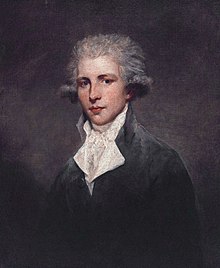Sir John St Aubyn, 5th Baronet

Sir John St Aubyn, 5th Baronet (17 May 1758 – 10 August 1839), was a British Member of Parliament, High Sheriff of Cornwall and Grand Master of the Freemasons. Born in London, he succeed to baronetcy on 12 October 1772, at which point he inherited the family's estate near Crowan, Cornwall.
Leben
John St Aubyn was born on 17 May 1758 at Golden Square, London. His parents were, Sir John St Aubyn, 4th Baronet, was a Member of Parliament and his wife, Elizabeth. St Aubyn's sister was Catherine St Aubyn, who was an amateur artist. He attended Westminster School between 1773 and 1777. St Aubyn then spent three years in France where he had a relationship with an Italian woman and had a daughter.[1]
St Aubyn's father died on 12 October 1772, at which point St Aubyn succeeded to baronetcy, inheriting the family estate near Crowan, Cornwall. He was High Sheriff of Cornwall for 1780 and was then Member of Parliament for Truro in 1784, for Penrhyn from 1784 to 1790 and for Helston from 1807 to 1812. St Aubyn was also a well known fossil collector who in addition to his own collection purchased the large collection possessed by Richard Greene, surgeon of Lichfield, d. 1793.[2] He was elected a Fellow of the Royal Society in 1797.[3]
The baronetcy became extinct on his death in August 1839, aged 81. His estate passed to his legitimate son, James and his illegitimate son Edward was created a baronet in his own right in 1866 and was the ancestor of the Barons St Levan. He is buried in Crowan in Cornwall with a monument carved by William Behnes.[4]
References
- ^ "St Aubyn, Sir John, fifth baronet (1758–1839)". Oxford Dictionary of National Biography (online ed.). Oxford University Press. doi:10.1093/ref:odnb/24481. (Subscription or UK public library membership required.)
- ^ Baird, Olga. "Richard Greene's Museum". Retrieved 2 November 2009.
- ^ "Library and Archive Catalogue". Royal Society. Retrieved 3 August 2012.
- ^ Dictionary of British Sculptors, 1660-1851, Rupert Gunnis,
External links
- Hansard 1803–2005: contributions in Parliament by Sir John St Aubyn
- Geological Society "Geoscientist magazine" - article about Sir John St Aubyn
- Use dmy dates from November 2012
- 1758 births
- 1839 deaths
- Baronets in the Baronetage of England
- Members of the Parliament of Great Britain for constituencies in Cornwall
- Members of the Parliament of the United Kingdom for constituencies in Cornwall
- British MPs 1784–90
- UK MPs 1807–12
- High Sheriffs of Cornwall
- Fellows of the Royal Society
- Baronet stubs
- Great Britain MP (1707–1800) for England stubs
- UK MP for England stubs
